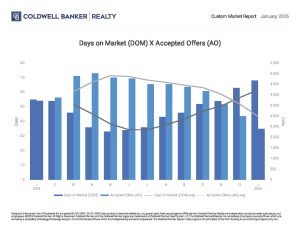Days In MLS (DIM) is a valuable statistic for both sellers and buyers in the real estate market. For sellers, it helps gauge the expected time a home might stay on the market before it goes pending. For buyers, it often indicates potential leverage in price negotiations. However, while a low DIM might suggest little room for price negotiation, properties with a longer DIM may seem ripe for a deal—but that’s not always the case.
Clarifying Real Estate Terms:
In real estate, “pending” refers to a status indicating that an offer on a home has been accepted, but the sale has not yet closed. This phase lasts until all financial and legal processes are completed. For example, a high-end property in Cherry Creek might list as pending once the terms are agreed upon, but before financing approvals and final sale.
Recently, a broker in Denver had a luxury listing that sat on the market for nearly 90 days with minimal activity but ultimately went pending at full price. This isn’t an isolated incident; numerous homes in the metro area have experienced similar patterns, especially those listed through the holiday season. This suggests that DIM remains a relevant indicator but not the sole factor in gauging market dynamics.
Market Trends in Denver’s Luxury Real Estate:
The luxury real estate market is subject to various economic and seasonal influences that can affect DIM. Economic fluctuations, like shifts in mortgage rates or broader financial market trends, can sway buyer sentiment, especially in premium markets. Seasonally, luxury properties in areas like the Denver Highlands see a slowdown in winter, leading to longer DIMs, but often recover with quicker sales in the spring as the market heats up.
Despite occasional market slowdowns, the recent trends indicate a revival in buyer activity post-holidays. Buyers who previously paused their searches are now actively making strong offers on homes that have been on the market longer, especially if they perceive good value without the initial competition. Thus, while DIM provides a framework, the true measure for both buyers and sellers should be the perceived value of the property.

Advice for Buyers and Sellers:
For buyers, while it’s useful to consider DIM in your strategy, focus primarily on the value the property offers to you. If a home meets your needs and is priced right, don’t let a higher DIM deter you from making a strong offer. For sellers, especially in the luxury market of Denver, aligning your home’s presentation and pricing with the market’s expectations is crucial. Ensuring your property is well-prepared and priced correctly can mitigate the effects of a longer DIM, attracting serious buyers ready to act.
Conclusion:
Whether you are buying or selling, understanding the nuances of DIM and market trends in the context of Denver’s luxury real estate landscape is crucial. Working with a knowledgeable agent who can provide insights specific to your area and needs will enhance your ability to navigate the market effectively. If you’re considering a move in the luxury market, now is an excellent time to assess your options and prepare for your next steps.

 Facebook
Facebook
 X
X
 Pinterest
Pinterest
 Copy Link
Copy Link
